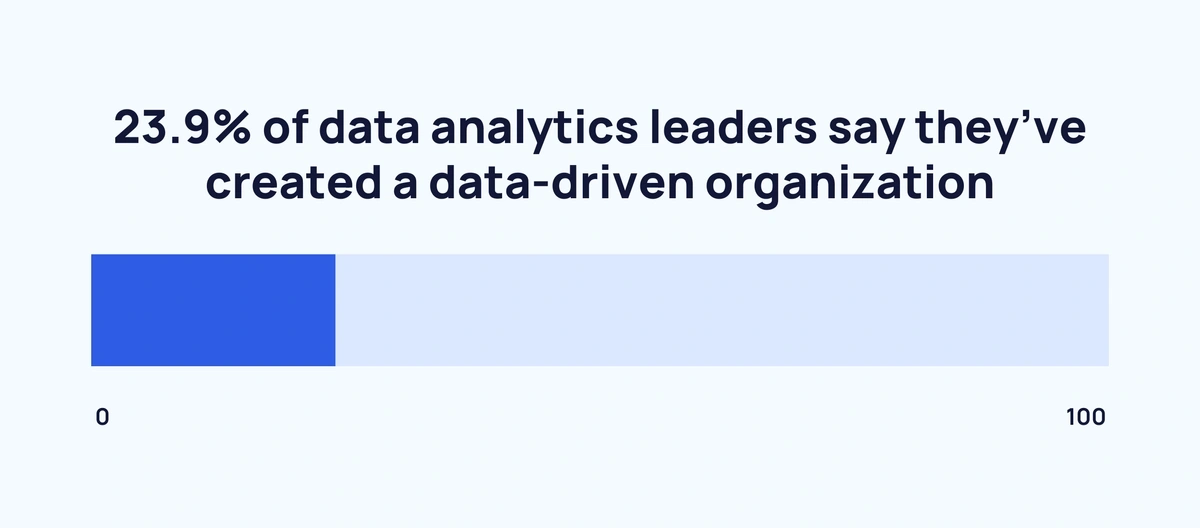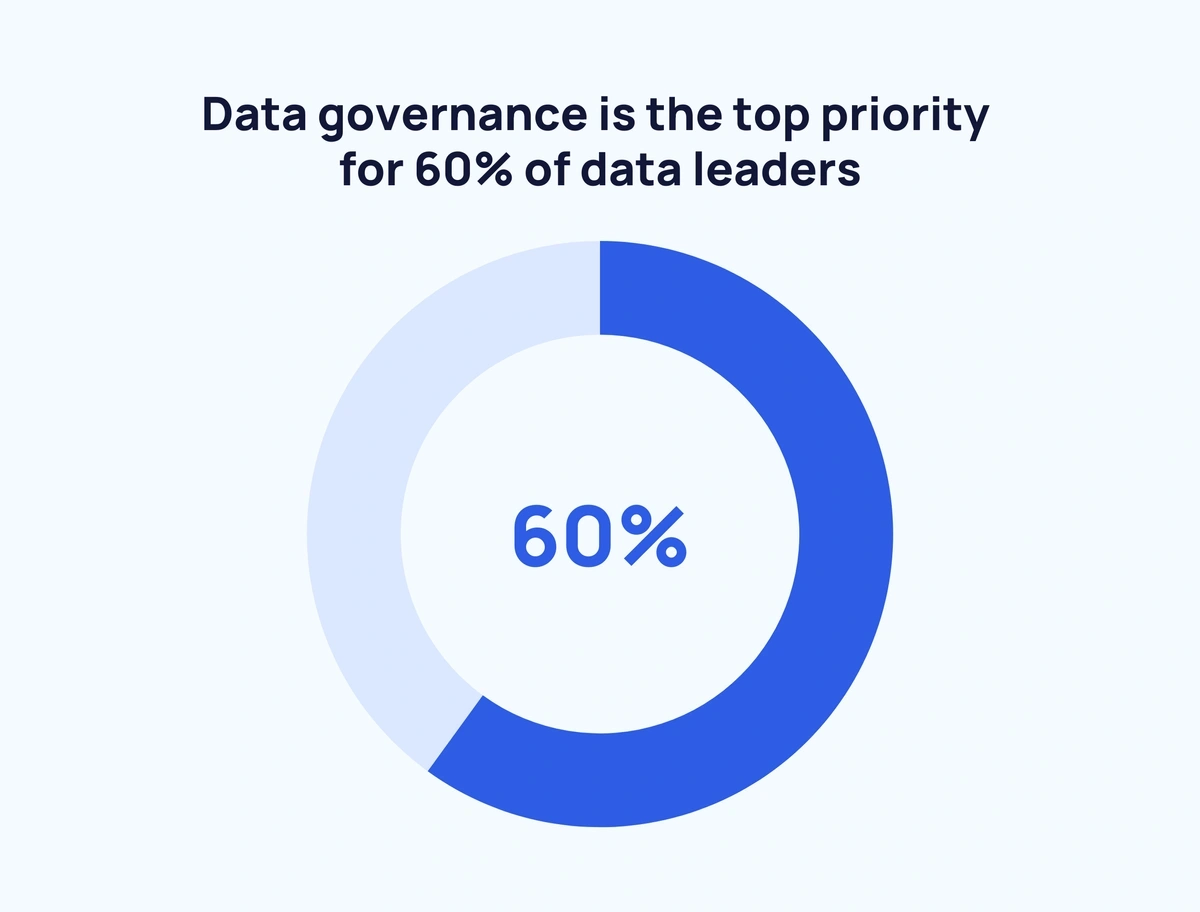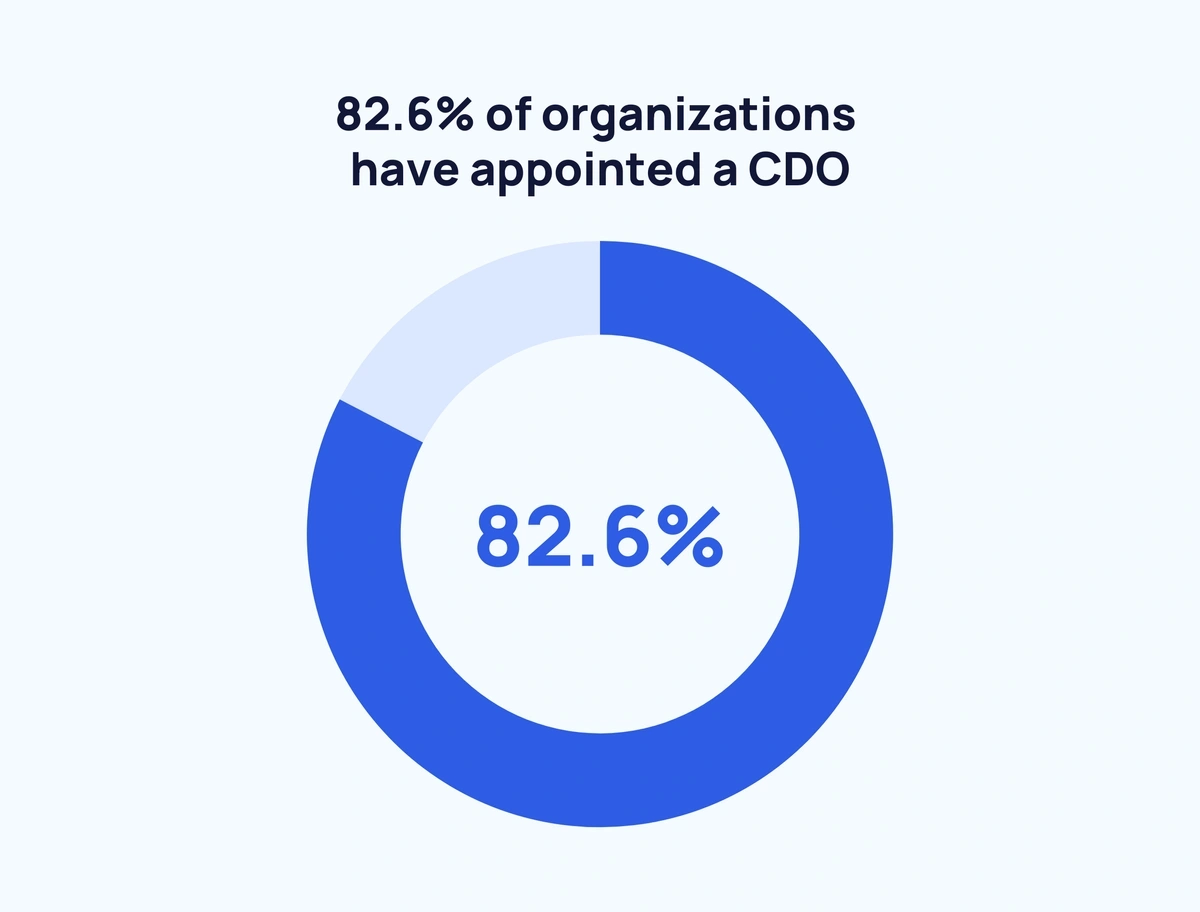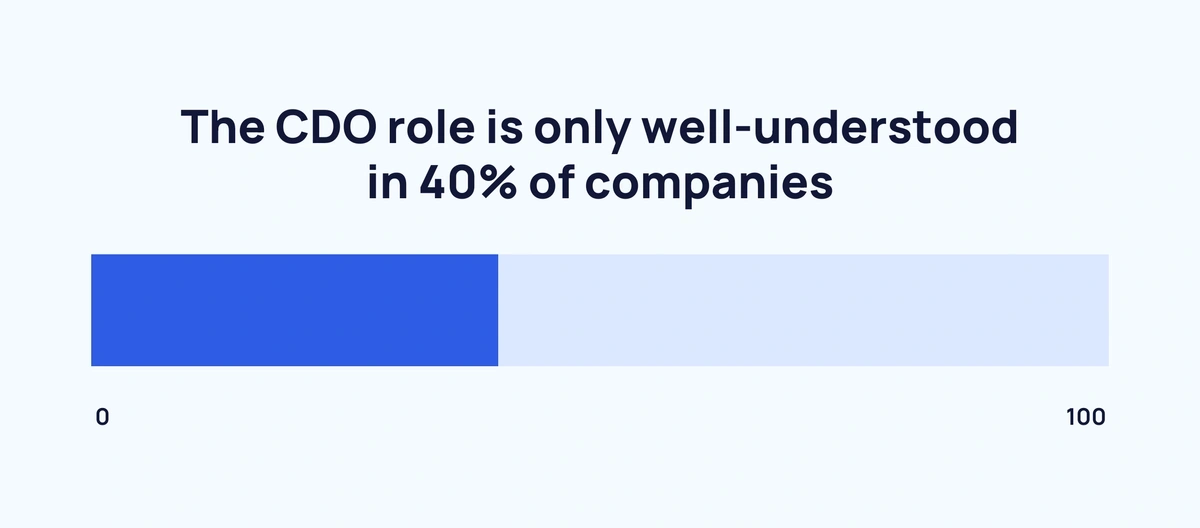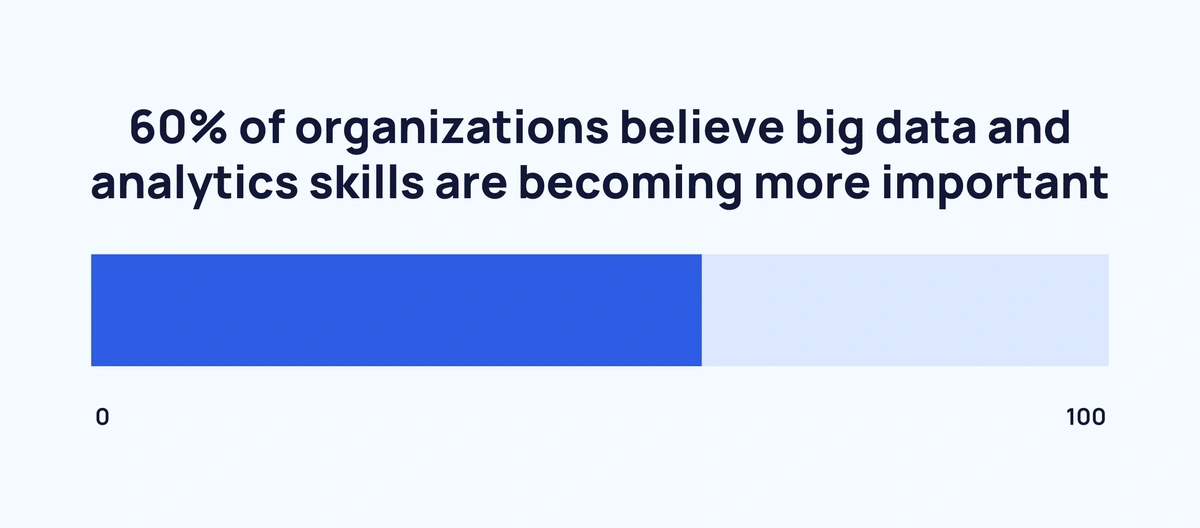
39+ Data Analytics Statistics (2024)
Every step we take in the digital world generates new raw data for organizations to use. But when data is in its raw form, it’s hard for companies to gain actionable insights. That’s where data analytics comes in.
Businesses use data analytics to shape strategies, streamline processes, and maximize profitability. To stay competitive in today’s digital world, organizations are striving to make data the center of every major department — from sales and finance to marketing and human resources.
Becoming a data-driven business doesn’t happen overnight. As companies strive to become data-driven, data analytics has evolved into a multi-billion dollar industry offering software, services, and training to support companies from every industry.
Here are the latest data analytics statistics and trends:
Top Data Analytics Statistics
This report examines over 30 up-to-date trends and stats. Before diving in, get started with these top statistics:
- The global big data analytics market is worth $307.52 billion
- Cloud computing is the top technology for companies investing in data and analytics
- 91.9% of organizations achieved measurable value from data and analytics investments in 2023
- 3 in 5 organizations are using data analytics to drive business innovation
- 56% of data leaders plan on increasing their budgets this year
- There could be up to 1.4 million new jobs created in data science and data analytics between 2023 and 2027
Data Analytics Market Statistics
Software companies and service providers make up the bulk of the global data analytics market. It’s dominated by companies like Microsoft, Oracle, SAP, and Salesforce — each providing companies with tools to get the most out of their data.
The global big data analytics market is valued at $348.21 billion (Fortune Business Insights)
Projections have the global big data analytics market hitting $924.39 billion by 2032 — a 13% CAGR. The organizations making the largest impact in the market include Azure, SAP, and IMB.
The Analytics as a Service (AaaS) market is projected to reach $132.9 billion by 2032 (Imarci)
Subscription-based analytics solutions hold a significant share of the global analytics market. AaaS is poised to grow by 20.7% per year between its $23.3 billion 2023 valuation and $132.9 billion 2032 projection.
The business analytics software market is estimated to reach approximately $177 billion in 2030 (Allied Market Research)
In 2020, AMR valued the business analytics software market at $61.10 billion. They expect the market to nearly triple in size by the end of the decade — an 11.2% CAGR. The biggest growth market over the next decade is the Asia-Pacific region, which projects to post a 12.9% CAGR.
Data Analytics Opportunities and Challenges
How are organizations using data analytics to drive business strategy? This section looks at data analytics from within organizations and examines the challenges and opportunities of becoming data-driven.
Chief Data Officers say Improving the way they use data and analytics is their top priority (Deloitte)
Deloitte asked 29 CDOs about their top 3 priorities for 2023 and beyond. 68% said they wished to improve the way they used data and analytics, 61% named delivering on data strategy as a top-3 priority, and 50% said they hoped to improve the data culture in their organizations.
One of the top challenges CDOs face is influencing executive committees (Deloitte)
Getting buy-in from the C-suite is a challenge for many executives, and CDOs are no exception. 71% say influencing the executive committee is a top-3 challenge. The other two main obstacles? Limited data skills (71%) and poor data literacy (54%).
91.9% of organizations achieved measurable value from data and analytics investments in 2023 (NewVantage Partners)
That’s a small decrease from 2022 when 92.1% of firms achieved value from D&A investments. But the long-term trend is impressive: In 2017, less than half (48.4%) of organizations were seeing a return on investment from data and analytics.
3 in 5 organizations are using data analytics to drive business innovation (NewVantage Partners)
59.5% of business leaders say their companies are using data analytics to drive business innovation. Unfortunately, most companies are falling behind in other data analytics areas. Only 2 in 5 organizations are competing in data analytics and managing data as an asset.
Around 1 in 4 data analytics leaders claim to have created a data-driven organization (NewVantage Partners)
One of the top challenges analytics leaders face is creating a data-driven culture within their organizations. The core issue is with culture, not technology. 79.8% of leaders point to culture, people, process, or organization as the primary obstacle to becoming data-driven.
On a more positive note, 70.9% of analytics leaders report that their organizations are receptive to change or transformation.
Cloud computing is the top technology for companies investing in data and analytics (Gartner)
Gartner asked 62 technology leaders about their organizations' data and analytics investments. 48% said they were investing in cloud computing, including IaaS, PaaS, and SaaS. Other key data analytics investment areas were artificial intelligence (35%), software (32%), Internet of Things (15%), and IT services (15%).
56% of data leaders are increasing their budgets (Atlan)
Companies are making big investments in data analytics. Over half are increasing budgets in 2023 compared to just 8% who report decreasing their budgets. 36% of data leaders report data analytics budgets remaining the same for 2023.
Data governance is the top priority for 3 in 5 data leaders (Atlan)
In an age of pervasive cyberattacks and stricter data regulations, it’s no surprise that governance — how organizations use, store, and secure data — is the top priority for most data leaders.
Other key priorities among data leaders are data quality (46%), data science (40%), self-service (34%), and DataOps (22%).
Just 33% of data leaders track their teams’ ROI (Atlan)
Just one-third of data leaders currently track their teams’ ROI: 23% track operational KPIs while 10% use quantitative and qualitative success metrics.
29% of data leaders say they’re in the early days of creating ways to measure ROI while another 29% say they use anecdotal methods to track their teams’ value.
83% of data and analytics professionals say their organizations consider data an asset (BARC)
74% also say their organizations are aware that data knowledge is key to successful data analytics operations. Those companies are investing — or plan on investing — in collecting and analyzing metadata.
Finance and accounting departments are considered the most data-driven within organizations (BARC)
59% of data and analytics leaders say finance and accounting departments are among the most data-driven within their organizations. Other departments successfully utilizing data are sales and distribution (44%), marketing (29%), production (27%), logistics and supply chain (27%), and purchasing (25%).
Chief Data Officer (CDO) Statistics
As data takes on a more prominent role in business operations, a new role has emerged: the CDO — or Chief Data Officer. While most organizations have appointed a CDO, many are still figuring out how the role fits into the overall corporate structure.
Around 4 in 5 organizations have a CDO (NewVantage Partners)
In 2012, just 12% of organizations had a Chief Data Officer. That number rose to 55.9% in 2017, 65% in 2021, and 73.7% in 2022. Today, less than 15% of organizations don’t have an appointed CDO.
28.3% of CDOs report to the Chief Operating Officer (NewVantage Partners)
As more organizations appoint CDOs, the debate continues over whether CDOs should report to business or technology C-Suite leaders. Here’s a breakdown of who CDOs are reporting to as of 2023:
- 28.3% report to the Chief Operating Officer (COO).
- 27.4% report to the Chief Information Officer (CIO).
- 15% report to the CEO.
- 8.8% report to the Chief Digital Officer.
- 3.5% report to the Chief Financial Officer (CFO).
Data strategy is the primary responsibility for 48.1% of CDOs (NewVantage Partners)
What is the CDO's primary responsibility in an organization? The most common answer is developing and executing a data strategy. In some organizations, CDOs’ primary responsibilities are analytics (16%), data governance (14.1%), or data management (12.3%).
Only 2 in 5 companies fully understand the CDO role (NewVantage Partners)
The CDO role is still evolving, and many firms are struggling to fit the role into their organizations. Nearly 3 in 5 companies don’t understand what the role does or should entail.
Turnover has been a problem: 1 in 3 organizations have had 2-4 CDOs since introducing the role.
Finally, only 36% of organizations say the CDO role is successful and established. 13% say the role struggles with turnover, and 3% say the CDO role has been an outright failure.
Data Analytics Career Trends
As the amount of corporate data grows exponentially, the demand for skilled data analysts continues to rise. Here are the latest stats and trends on this thriving career field.
Organizations view big-data analytics as the technology most likely to create new jobs over the next 5 years (World Economic Forum)
New technology typically shakes up the existing job market. It can create new roles or eliminate obsolete jobs. When it comes to data analytics tech, 58% of companies view new technology as a job creator.
3 in 5 organizations believe big data and analytics skills are becoming more important (World Economic Forum)
As companies strive to become more data-driven and establish a “data culture,” data analytics skills are critical. Other analytics-relevant skills of increasing importance are analytical thinking (72%), technological literacy (68%), and systems thinking (60%).
There could be up to 1.4 million new jobs created in data science and data analytics between 2023 and 2027 (World Economic Forum)
Experts predict a 30-35% growth in demand for data analysts, data scientists, big data specialists, business intelligence analysts, database and network professionals, and data engineers.
Wrap Up
As companies seek to become more data-driven and establish a “data culture,” their need for data analytics and data professionals will continue to rise. Some companies have clearly defined the role data analytics plays in their day-to-day operations. Others are still adjusting.
One thing is certain: the ocean of data in the world is only going to keep expanding. The data analytics industry and workforce will keep expanding with it.
For another deep dive, take a look at these 30+ incredible Big Data statistics.
Stop Guessing, Start Growing 🚀
Use real-time topic data to create content that resonates and brings results.
Exploding Topics is owned by Semrush. Our mission is to provide accurate data and expert insights on emerging trends. Unless otherwise noted, this page’s content was written by either an employee or a paid contractor of Semrush Inc.
Share
Newsletter Signup
By clicking “Subscribe” you agree to Semrush Privacy Policy and consent to Semrush using your contact data for newsletter purposes
Written By


Josh is the Co-Founder and CTO of Exploding Topics. Josh has led Exploding Topics product development from the first line of co... Read more


